It was on a fine Saturday morning, that I decided to take a four and a half kilometre walk that was organised by the Nature Society of Singapore, along a part of the industrial history of a Singapore that was still finding its feet in the uncertain climate that had surrounded Singapore in the 1960s. It was at a point in time when Singapore was contemplating joining what was then referred to as the Federation, the Federation of Malayan States, better known as Malaya, that work on the Jurong Industrial Estate, a massive project that played a significant part of the island nation’s rapid industrialisation in its early years. There is no doubt that the transformation of a marshy and hilly ground which would have been unsuitable for development had the effort that flattened the hills and fill up the swamps over a 3.5 hectare area to not just build an industrial complex, but provide housing and amenities in the area to the workforce that cost hundreds of millions – the biggest single project that had been taken on by the forward looking self-government and the brainchild of the then Finance Minister, the late Dr. Goh Keng Swee, contributed much to what was later, a newly independent Singapore’s economic success. Along with the industrial complex that was to set Singapore on its feet, there was of course the big effort to provide infrastructure to support the massive project, which included a somewhat forgotten extension to the railway network on the island, the old Jurong Line.
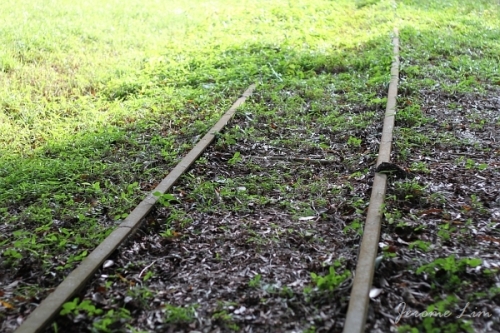
The now abandoned old Jurong Line was built in the 1960s to serve the Jurong Industrial Estate which was being developed.

The line runs through a corridor which has been relatively untouched by the modernisation that has overtaken the island over the last four decades and forms part of a proposal by the Nature Society of Singapore to preserve the former railway corridors as Green Corridors.
Jurong was in my childhood, one of the ends of the earth, being in what I had envisaged as a forsaken part of the island, good only for the seafood at Tuas village, that meant the long ride along the long and winding old Jurong Road that took one past the creepy stretch where the old Bulim cemetery was located. It was also the object of many school excursions to the area which had in the 1970s, the Jurong Birdpark added to the list of attractions that meant the long ride on the chartered bus which would pass the wonderfully wide tree lined avenue named International Road and culminate in the smell that we would always look forward to with anticipation – that of the aroma of chocolate that would invariably waft out of the Van Houten factory that stood on Jalan Boon Lay. It was only later that I came to know Jurong much better, spending 16 years of my life working in a shipyard at the end of Benoi Road.

The human train through over the old railway line ...
It was around when I had first started work there that I started to notice the old Jurong Line, only once spotting a train passing over a level crossing that might have been at Tanjong Kling Road, not significant enough to have caught a mind that was distracted by the early days of my career. I had of course known about the bridges – a truss bridge, similar in construction and appearance to the glorious truss bridges of the main Railway Line that gives the Bukit Timah area some of its distinctive character, that crossed the Sungei Ulu Pandan that was visible from Clementi Road on the double decker bus service number 74 that I occasionally caught home from Clementi during my days in Singapore Polytechnic, as well as a less distinct on that crossed the Pandan River. Beyond noticing the obvious signs of the Jurong Line, I never did find the urge to learn about it until maybe a recent bout of nostalgia for the railway in Singapore brought about by the news that we will see the last of the trains crossing the island come the first day of July this year prompted the urge in me to explore what is now a disused line, and so when I heard of the ramble organised by the Nature Society, I decided to get dirty and muddy in the effort to learn more of the line.

The truss bridge across the Sungei Ulu Pandan at Clementi is a very well recognised landmark.
The walk along the line started at Teban Gardens, which itself was a housing estate that owes its own development to Jurong Industrial Estate which it sits on the fringe of, having been constructed in the early 1970s to supplement low cost housing in the area which had been in high demand as more people found jobs in the Industrial Estate. The first flats were completed in 1976 by the Jurong Town Corporation (JTC) which had been the body responsible for the development of the Indistrial Estate and the flats in the area – along with other JTC developed housing estates in the west of Singapore, have a distinct character compared to the estates developed by the Housing and Development Board (HDB) during that time. The start of the walk in the setting of the fast rising sun, allowed the plots of vegetables and fruit trees to be revealed along that part of the corridor along that area on the approach to the abandoned tunnel that runs under Jurong Town Hall Road, a scene reminiscent of some of the rural scenes of Singapore that I had hitherto thought had been lost in the wave of development that has swept over Singapore. It was nice to return to the that Singapore for a while and take in the “fresh” country air that came with what appeared to be the ample use of fertilizer on the plots of vegetables.

Crossing what were the tracks at Teban Gardens.
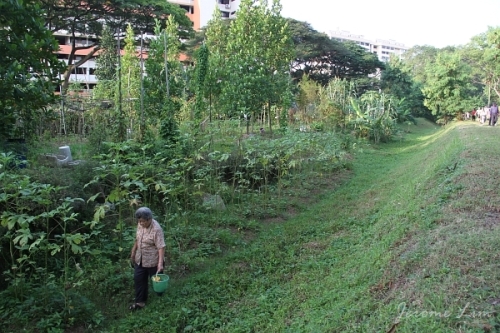
A scene perhaps from the rural Singapore of old - small scale farming takes place along some tracts of land through which the corridor passes.

More scenes from what rural Singapore might have once looked like.
It was refreshing start to the walk which continued through one of the five tunnels that the line had featured when it was operational, along with eight steel bridges, three of which we walked across or walked by. Built at a cost of S$5.9 Million by the Malayan Railway with a loan from the Economic Development Board (EDB), construction on the line started in 1963 and was only completed in 1966 with total of 19.3 kilometres of tracks laid, although a public run was made as early as in November 1965. The first service commenced with its opening by Dato Ahmad bin Perang, the then General Manager of the Malayan Railway on 4 March 1966. The line, which branched off at Bukit Timah station and ran under a tunnel across Clementi Road towards the west, ended up at Shipyard Road behind the Mobil Refinery which was then being constructed, with a branch line running to the National Iron and Steel Mills (the estate’s first factory) and Jurong Port, and had apparently not been as well used as envisaged, and operation of the line finally ended in the mid 1990s without much fanfare, with the land being returned to the State and lies abandoned for the close to two decades that have passed.

The line featured five tunnels, including this one running under Jurong Town Hall Road.

Another view through the tunnel ...

The light at the end of the tunnel
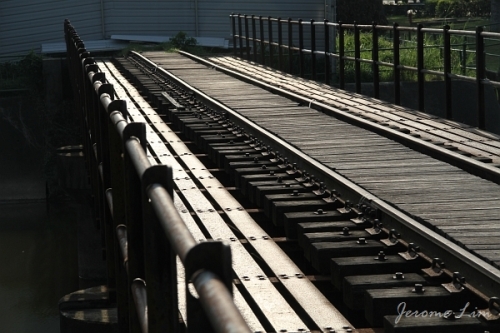
The line also featured eight steel bridges, including this girder bridge across the Pandan River, along its 19.3 km of tracks from Bukit Timah Station to Shipyard Road and Jurong Port.
The abandonment was certainly pretty much in evidence throughout the walk, not just with “Danger” signs pretty much rendering the tunnel and the bridges along the route places we should have really avoided walking through or on. Trudging through the dark and dingy tunnel certainly wasn’t a walk in the park as the thick layer of mud that lined the ground meant a slow trudge towards the light at the end of the tunnel which was a small opening in the zinc sheet that was meant to prevent access into the tunnel at the other end. The first of the bridges we passed was the one across the Pandan River, which looked a little worse for wear and was boarded up to prevent access to it. After that, it was through the Faber Gardens corridor where besides the obvious signs of the abandoned tracks, some being overrun by the vegetation, there were also some nice bits of nature to take in, with even a creek that showed evidence of a swamp in the area with some swamp plants being very much in evidence. It was in the area where two members of the Shield Bug family said hello without giving off the almighty stink that they are known for. This certainly is reason enough to support the Nature Society’s proposal to turn the rail corridors into green corridors.

Signs of abandonment were pretty much in evidence all along the tracks ... this one at the east end of the tunnel ...

... and one at the Pandan River bridge ...

A train undercarriage's eye view of the bridge over the Pandan River.

An unspoilt part of Singapore - a creek by the old Jurong Line ... one of the compelling reasons to support the Nature Society's proposal to turn the areas around the tracks into a Green Corridor.

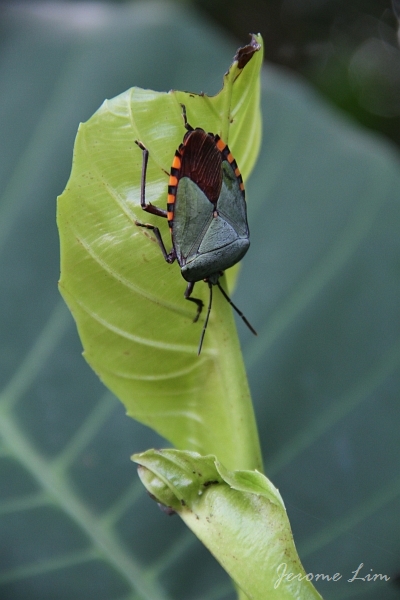
Shield bugs ... not uncommon, but rarely seen in urban Singapore these days.

Nature disturbed by the line but relatively unspoilt.

and in some instances, reclaiming their place on the old abandoned tracks.

More evidence of nature reclaiming the areas around the abandoned tracks.
It wasn’t long before we got to the Sunset Strip – the area behind Clementi Town along the Sungei Ulu Pandan that leads up to Sunset Way. That was where we walked into the Chinese temple and a few more reminders of a rural Singapore that is no more, including a water hyacinth pond (water hyacinth ponds were commonly seen as these were often used as fodder for pigs as well as in ponds treating pig waste in the old kampungs). From there, it was across first the rickety old truss bridge that the lack of maintenance on it very evident and looks as it it would be destined for the scrap yard unless my friends in the Nature Society have their way … that provided an excellent photo opportunity and despite the signs warning us not to cross and the clear evidence of a structure that bears the scars of being left in the hot and humid environment without any renewal made of coatings that would have kept the corrosive effects of the environment at bay, proved to be a safer bridge to walk across than the operational ones along the Bukit Timah corridor. It wasn’t far then for the human train to reach the sunset – Sunset Way – where another bridge – a grider bridge provides an overhead crossing over the road … where the short, but very interesting walk ended, leaving me with a much deeper impression of the old Jurong Line, and certainly of the proposal to turn the corridor into a green corridor, which I hope, won’t as the old Railways across Singapore, ride and fade into the sunset.

A temple by the former Railway land along the Sungei Ulu Pandan.
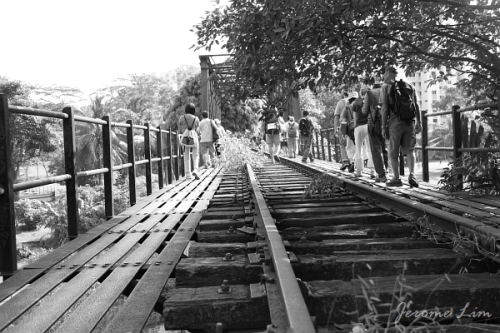
Crossing the truss bridge across Sungei Ulu Pandan ...

Another view across the truss bridge.

The last leg of the walk towards Sunset Way.
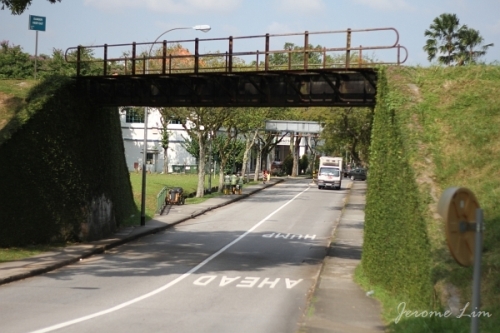
The girder bridge over Sunset Way.
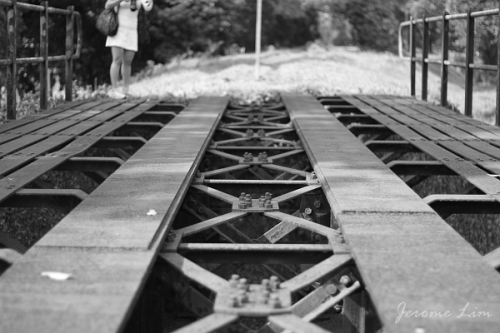
The view across the girder bridge at Sunset Way.





